RSAF’s newest tanker aircraft now fully operational; may soon automatically refuel airborne jets
Manoeuvring the huge tanker's boom to refuel RSAF fighter jets needs a deft touch and high level of coordination, as CNA discovered when it tried the simulator used to train tanker crew.
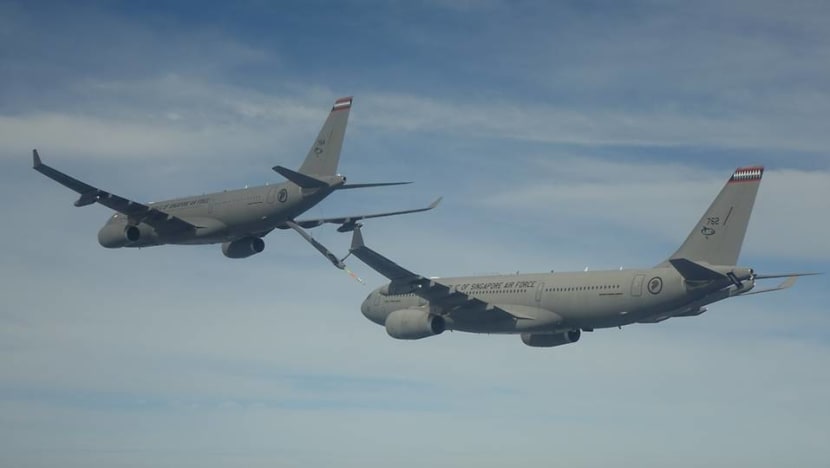
An RSAF Airbus A330 multi-role tanker transport (MRTT) tanking with another MRTT. (Photo: MINDEF)
SINGAPORE: My grip on the left and right joysticks tightened as the F-15SG fighter jet moved into position on the screen in front of me.
I was in a virtual cockpit of a Republic of Singapore Air Force (RSAF) Airbus A330 multi-role tanker transport (MRTT), and my mission was to refuel the fighter jet in mid-air.
My left hand was in charge of extending the MRTT’s fuel boom. My right hand controlled where the boom moved. My eyes focused on a spinning set of dials with numbers that tracked the boom’s position.
On Friday (Apr 16), reporters were given a chance to try out the simulator used by RSAF refuelling crew training on the MRTT, which can carry more fuel, cargo and passengers than its predecessor, the KC-135.
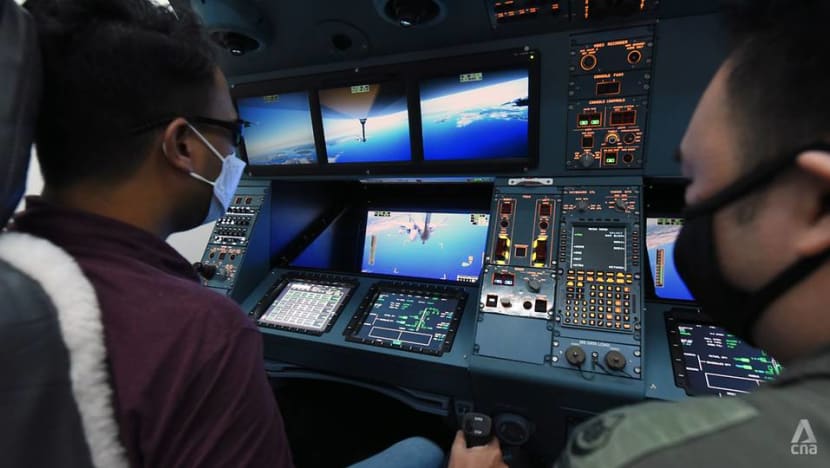
This makes the MRTT a strategic and flexible asset that can keep fighter jets airborne longer, transport essential supplies or evacuate sick and injured personnel.
The MRTT was first delivered to the RSAF in 2018 and declared fully operational in a ceremony at Changi Air Base (East) on Tuesday. This means that the MRTT has continuously proven it can successfully refuel the RSAF aircraft it was designed to work with both day and night.

Back to the simulator session, my eyes widened in anticipation as the boom floated close to the fighter jet’s fuel receptacle, which appeared as a tiny black hole on the screen.
The numbers on the dials showed my boom was not positioned in the recommended range. The software recommended further tweaks by conjuring up green arrows on the screen.
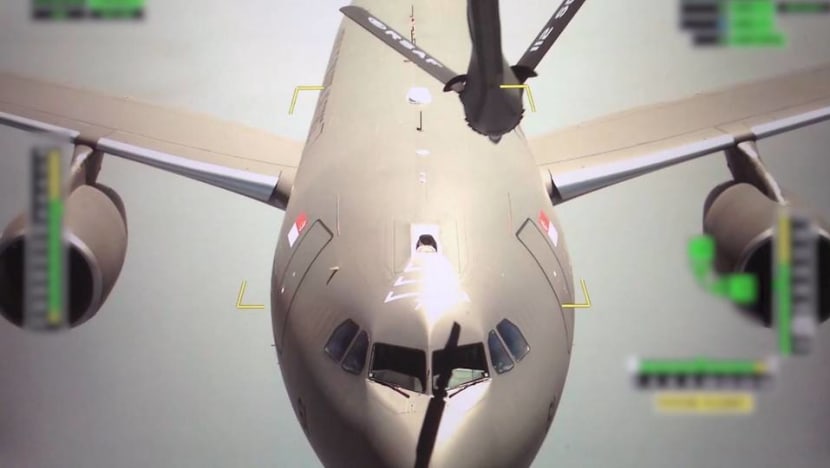
I moved my hands in what I thought were very minor adjustments, but the boom started swaying erratically. “Use your wrist instead of your arms,” the instructor sitting next to me said.
While this felt like the ultimate multi-tasking and hand-eye coordination arcade game, the stakes in real life are extremely high. One wrong move and the boom could smash into a fighter jet’s glass canopy, killing its crew.
READ: A wild ride aboard RSAF’s newest tanker - the high-value target keeping fighters airborne
I brushed those thoughts away. Almost there, a voice in my head squealed as I slowly extended the boom to make the crucial connection. Just as I thought it was going in, the boom slipped to the left and scraped the multimillion-dollar fighter jet.
It took more attempts, wincing and surface damage before the boom finally snapped in. My performance was “not bad”, the instructor said. I was just relieved that I did not kill anyone.
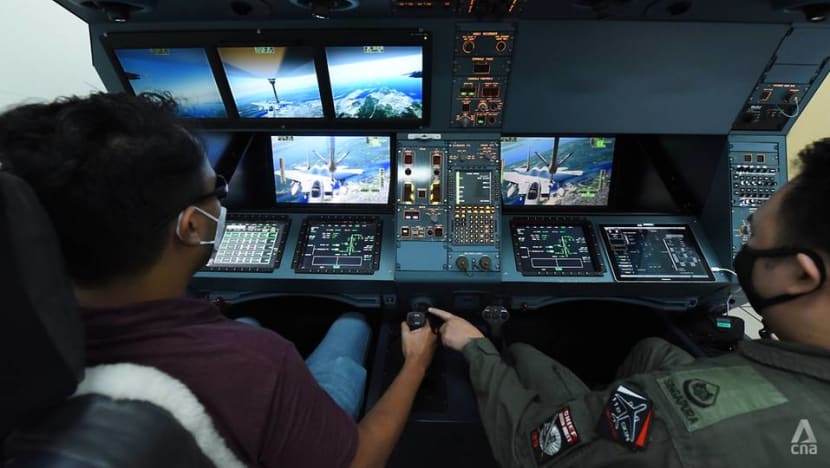
First Sergeant (1SG) Lim Pei Zhen, an air refuelling operator aboard the MRTT, said the location of the F-15SG’s fuel receptacle – the device that connects to the MRTT’s boom – on its left hand side, as opposed to the central position on the F-16, brings some challenges.
“The issue with receivers with side receptacles is that whenever we extend our boom, it will tend to have this move-in effect where it will move towards the canopy of the receiver aircraft,” the 25-year-old said.
The MRTT’s refuelling system helps to counter this by letting the crew select a specific mode that calibrates the boom’s movements to be more in tune with the characteristics of the F-15SG.
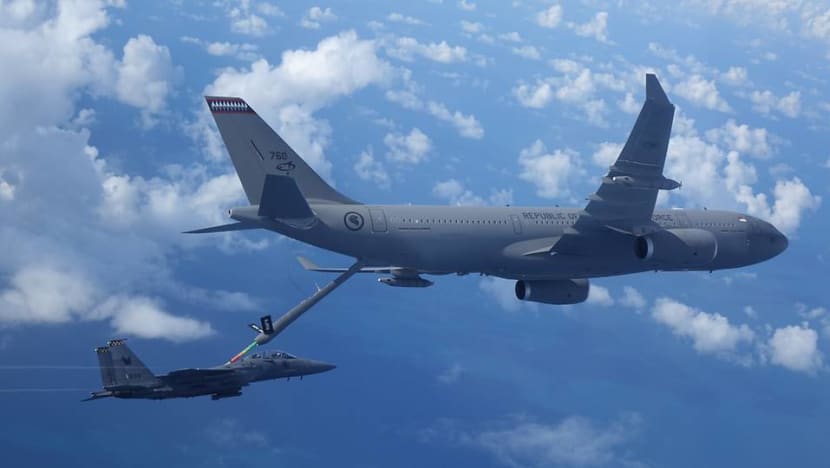
1SG Lim, who previously did refuelling on the KC-135, highlighted the importance of being able to practise on the simulator before performing the task on a live flight. The KC-135 did not have a refuelling simulator.
“Before I even got my F-15SG qualification, I have to ensure that I have gone through the simulator to prevent any heart attack to the instructor,” she added.
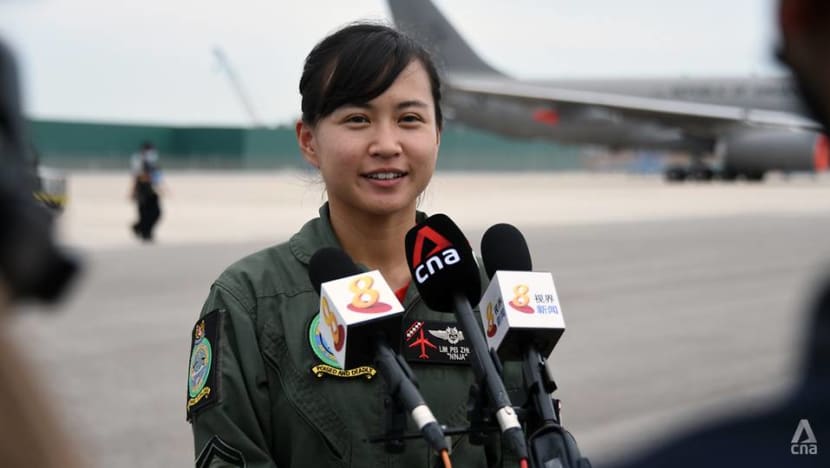
The simulator replicates the operator’s consoles and is equipped with flight management and aerial refuelling system panels, like audio and visual warnings, to let operators familiarise themselves with the instruments.
The simulator can produce a wide range of operational scenarios, including turbulent weather and the refuelling of different types of aircraft.
AUTOMATIC REFUELLING
The MRTT can refuel the RSAF’s F-15SG and F-16 fighter jets, as well as another MRTT so the tankers can fly farther during extended missions. Tanker-to-tanker refuelling was not possible on the KC-135.
One MRTT can carry up to 111,000kg of fuel, 20 per cent more than what the KC-135 could carry.
This is enough to fill the internal fuel tanks of about 35 F-16s, according to calculations based on the fighter jet’s fuel capacity, and allow the MRTT to fly non-stop to all of the RSAF’s overseas deployments such as in the US.
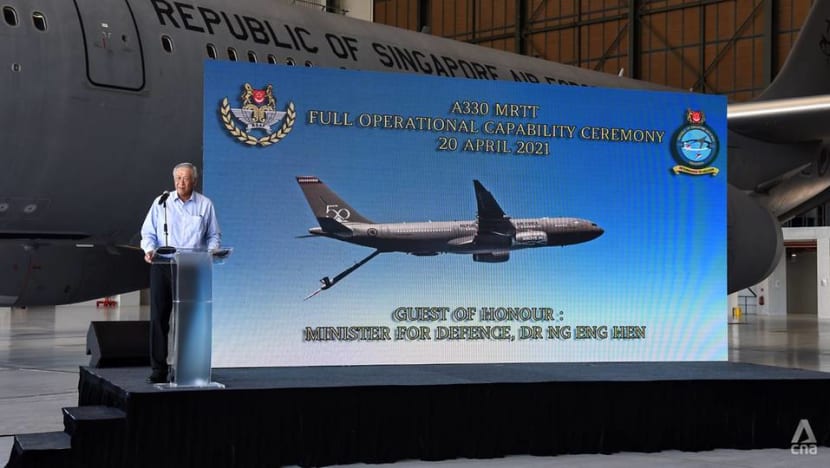
Speaking at the ceremony on Tuesday, Defence Minister Ng Eng Hen said: “For our fighter aircraft, the MRTT provides the capacity to reach faraway parts of the globe and correspondingly, assurance that we would be able to recover our assets from anywhere in the world when the situation warrants.”
READ: SAF on a mission to go green, starting with new hangar that produces more energy than it consumes
The RSAF is working with the Defence Science and Technology Agency (DSTA) and Airbus to introduce a feature on the MRTT that automatically tracks the receiving aircraft, makes contact and starts the fuel transfer. Once refuelling is done, the boom will retract automatically.
If the tanker malfunctions or the receiver is not stable enough, the system can disconnect and clear the boom away from the receiver safely, Airbus said in a news release in February last year.
“Under the agreement, an RSAF A330 MRTT will take part in the ongoing development, flight test campaign and final certification programme,” Airbus said, adding that it aims for certification in 2021.
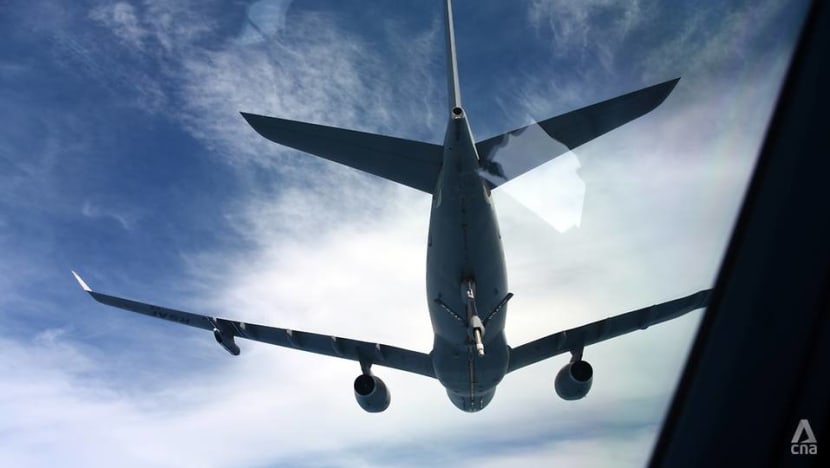
DSTA principal engineer Ang Wei Qin, 31, said the RSAF will eventually be the first air force in the world to operationalise this technology.
“It is progressing well and we are working with Airbus and RSAF very well on it,” she said, although she added that it will not replace the role of air refuelling operators.
“They are always needed because they ensure the safety of air-to-air refuelling operations and play a critical role in mission planning,” she explained.
FULL OPERATIONAL CAPABILITY
Dr Ng praised the partnership between RSAF and DSTA in overcoming the MRTT’s early issues.
“Their expertise and persistence enabled operational and technical problems to be addressed, such as the air-to-air refuelling boom not performing up to the manufacturer’s standards during flight trials,” he said.
“DSTA engineers worked with the original equipment manufacturer to resolve the problem and their proposed modifications are now being assessed and promulgated across the global fleet of MRTTs.”
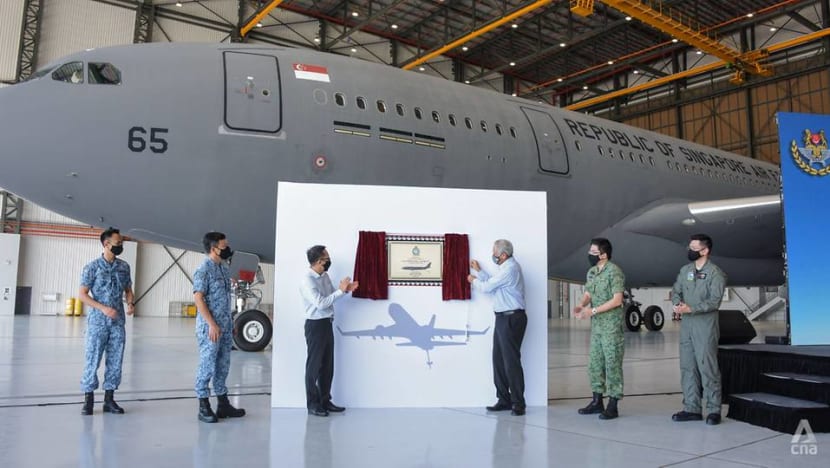
This was also the case when DSTA conducted a workload study to reduce the MRTT’s initial four-person crew to three – two pilots and an air refuelling operator – to save on manpower and costs.
This was done by re-assigning mission coordinating duties, like logistics and passenger management, to the co-pilot and air refuelling operator. Now, the three-person crew is standard across MRTTs around the world.
“The attainment of full operational capability (FOC) by 112 Squadron for the Airbus A330 MRTT obviously marks a significant milestone in the capabilities of the RSAF,” Dr Ng added.
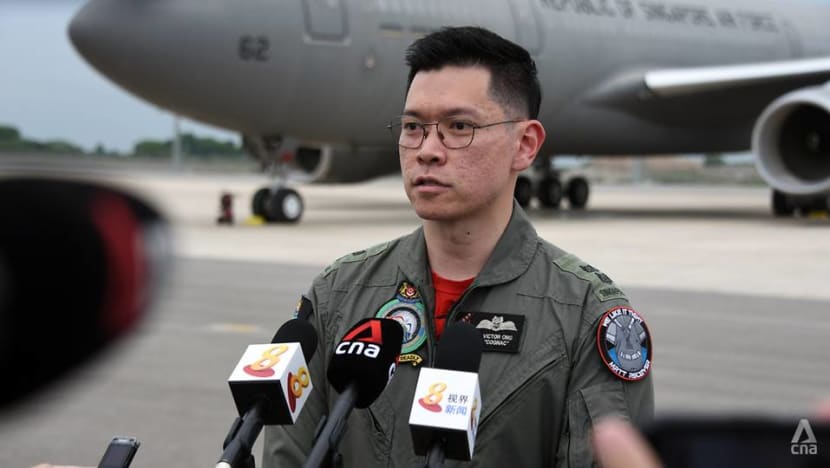
Lieutenant Colonel Victor Ong, commanding officer of 112 Squadron which flies the MRTT, said the tanker achieved FOC after passing several assessments on refuelling both types of RSAF fighter jets.
“The second part of the FOC criteria was the new capability, which is the tanker-to-tanker (refuelling) capability,” the 38-year-old said.
“So that involved a lot more of our training on the pilots, figuring out how to conduct the operations as efficiently as we can, because part of the criteria involves time and space.”
TANKER-TO-TANKER REFUELLING
While much has been said on the complexities of refuelling a jet in mid-air, skill is also needed on the part of the receiving aircraft.
Aircraft are not built to fly so close to each other, and mid-air refuelling operations are considered dangerous.
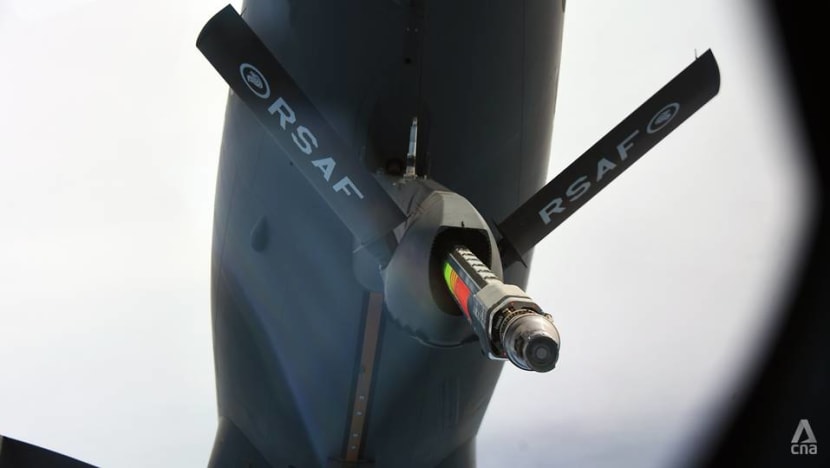
Reporters on Friday were taken on a live MRTT flight, to witness tanker-to-tanker refuelling before the pilot embarked on a series of stomach-churning evasive manoeuvres.
During refuelling, I sat behind the pilots as the MRTT flew behind and in sync with another tanker, the latter’s rear end and boom looming large through the cockpit windows. It was surreal to see two huge lumps of metal flying so near to each other.
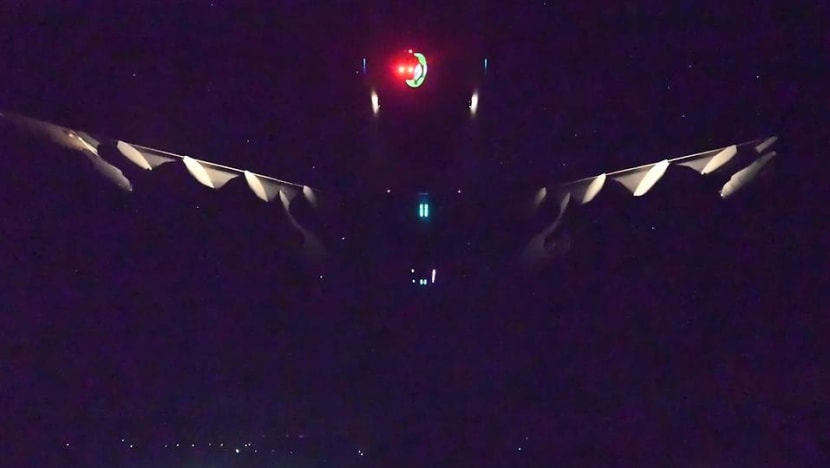
The pilot seated on the right had control. The autopilot was off; the software that pre-empts airborne collisions using proximity sensors was deactivated and put on standby. The pilot gripped the thrust levers with his left hand while his right hand cajoled the side stick, steering the Airbus into position.
The pilot was now in constant contact with the air refuelling operator on the MRTT in front. As its boom drifted closer, he used rows of red, yellow and green lights on the tanker’s belly for guidance. Like traffic lights, they told him to make minor positional adjustments, perfectly aligning the receptacle with the boom.
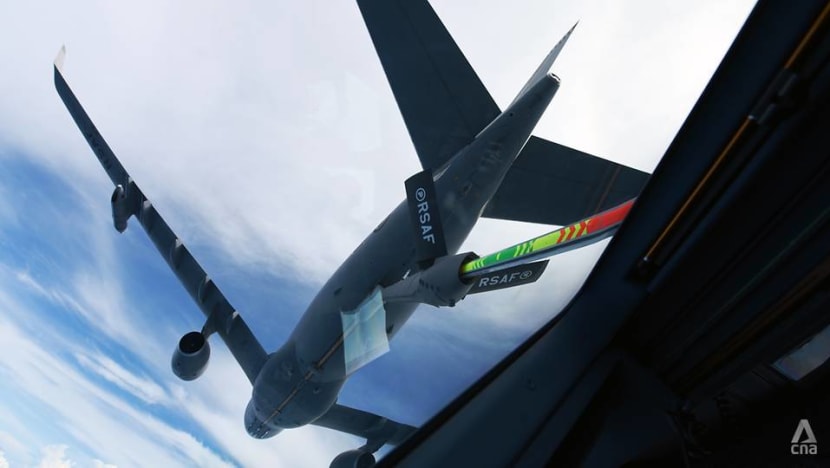
The rumbling above the cockpit grew louder, indicating that the boom was right on top and about to snap into place. The traffic lights turned green. Mission accomplished.
AEROMEDICAL EVACUATION
Besides refuelling, the MRTT can transport passengers and cargo during disaster relief missions or peacetime support operations.
It can carry up to 266 passengers or 37,000kg of cargo, a huge upgrade on the KC-135 which could ferry about 60 people and two times less cargo.
The MRTT can also be configured for aeromedical evacuation missions, by replacing the seats in the middle section of the plane with three different types of medical stations, depending on the condition of patients.
A specialised in-flight RSAF medical team will monitor and manage patients’ medical conditions closely throughout the flight.
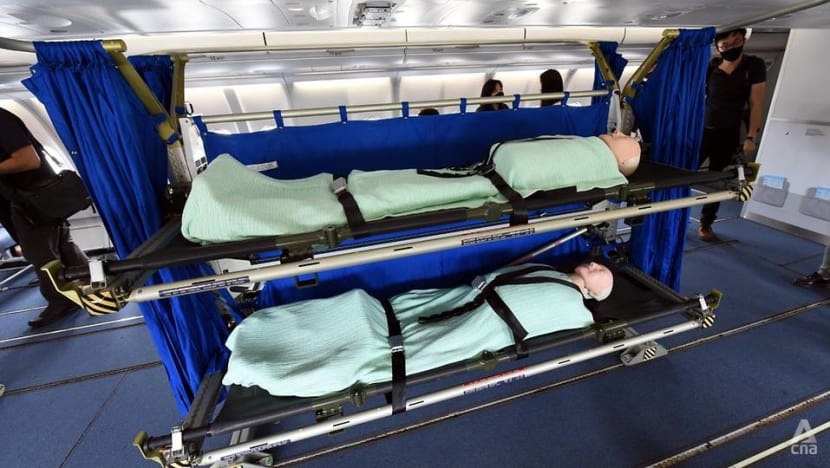
The first kind of station involves basic stretchers and curtains secured to the cabin for patients that need light to moderate care.
The second station, akin to an intensive care unit (ICU), is a more elaborate set-up fitted with medical equipment like a defibrillator, ventilator and blood warmer.
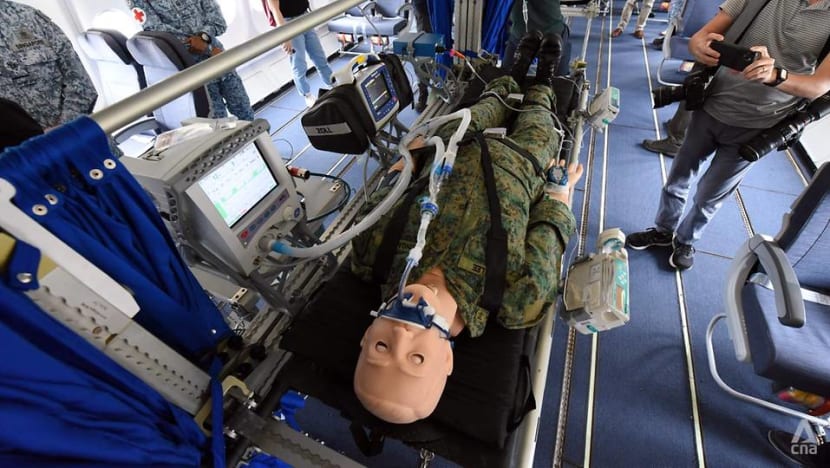
The third station, comprising an incubator-like negative pressure individual isolation system, is for patients with infectious diseases like Ebola or the Severe Acute Respiratory Syndrome.
Medical personnel attending to these patients wear full personal protective equipment and reach them through ports in the side of the system.
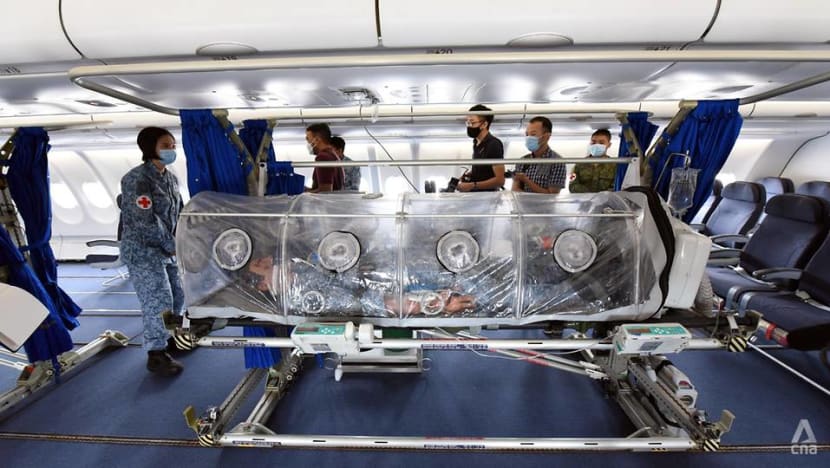
The MRTT can be configured to care for three ICU-level patients, or for 12 other patients requiring light to moderate care. The stations come with their own power supply and are elevated to the hip level for easy patient accessibility.
It is a significant upgrade on the medical facilities in the KC-135, which strapped patients to the floor and required crew to haul in an 80kg battery pack to power the medical equipment.
Major (Dr) Magdalene Lee, head medical plans and training branch at the Air Force Medical Services, said the MRTT’s aeromedical evacuation capability allows the Singapore Armed Forces to project its medical forces around the world.
“So that our personnel who are training or deployed in overseas rotations can receive good healthcare and medical support,” she said.












